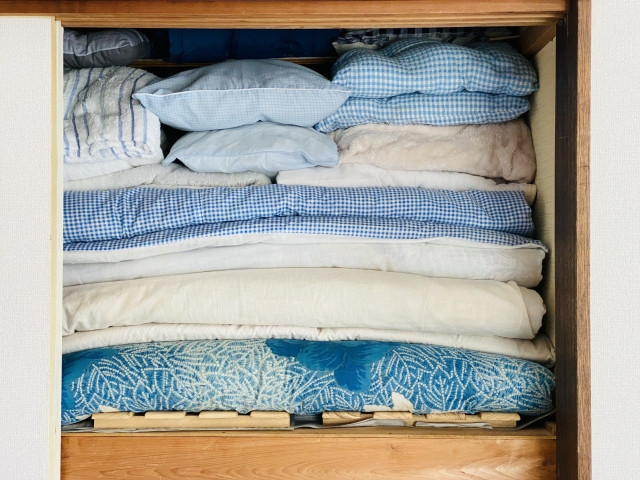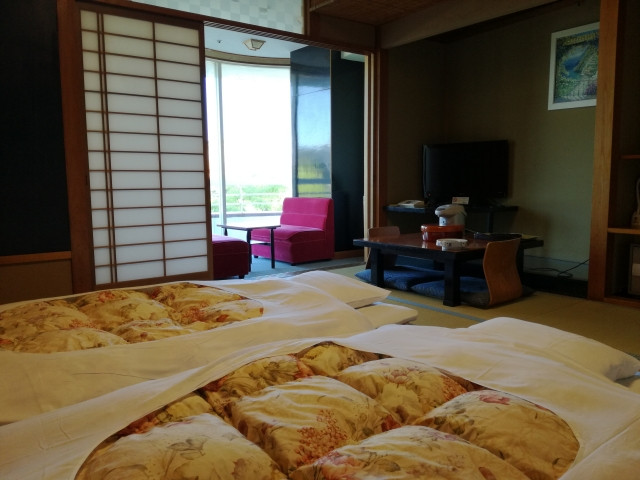At the end of all adventures, the wrapping up must always be a nice, long, and good sleep. Many Japanese households have futons, and the same stands true for Ryokans in Japan. Though they serve the same function, a futon and a western bed have their differences.
Table of Contents
The Japanese futon
After a long, difficult day of hard work or walking from your Japan tour, everyone deserves a long and relaxing sleep. Fortunately, Japan invented an innovative way to be comfortable and have a good night’s sleep, even with limited space!
The futon is a Japanese bedding set that has both a mattress (called shikibuton in Japanese) and duvet or large blanket (called kakebuton). There is often very limited space in a Japanese house or apartment for an extra guest or person to sleep if the need arises. The futon is the perfect way for people to achieve quality sleep, even if there is limited physical space available. The mattress and the duvet can be folded into smaller squares and stored away in a closet when not in use.
Futons can serve as beddings during the night, and since it is very portable, the bedroom can be transformed into a living room during the day. When guests arrive, the futon can be easily assembled to sleep comfortably. Futons are also usually used on top of a Japanese tatami mat to avoid gathering dirt and dust from the floor.
Writer's Pick
All about futon

There are three major parts in the traditional Japanese futon. These are the mattress, the duvet, and the pillow. The mattress and duvet are made out of cotton, which is an adaptable material that contributes to making a comfortable bed in the dead winter and make people feel cool amidst the scorching hot summers in Japan. The pillow, on the other hand, is traditionally filled with beans. All three components of a Japanese futon can easily be folded, cleaned, and put away for one's convenience.
Customary, a type of a floor mat called "tatami" was used in earlier Japan to create a gap between the futon and the floor, separating the futon away from the floor's coldness. Many Japanese houses and apartments still have tatami floors today. Some people are able to use their futons for ten years or more!
Back in Japan's imperial days, futons could only be afforded by the royal family because of the scarcity of cotton. Now that cotton is manufactured globally, many people in Japan can afford and own futons. Japanese futons can usually be purchased in particular Japanese sleep stores, so make sure to be on the lookout for a specialty sleep store in Japan when you are in the vicinity, or you may also check online to order your very own Japanese futon. The price range for Japanese futons is around 20,000 to 60,000 yen which varies depending on the size. Of course, for quality, it can even be much more expensive, but it’s said to last you for decades if you treat it right.
How to properly set a futon
Since futons are very flexible, it can be set anywhere in the household with a flat surface. Traditionally, the older types of Japanese futons are folded, but some futons are designed to be rolled rather than folded in today's time. First, fold or roll out the mat, set the sheets on top if they’re not already attached, then set the pillow and pull the duvet over you. Done!
How to properly store a futon after use

For futons to last longer, they should be properly taken care of. Some houses come with oshi-ire, a special closet for futon. But apartments don’t always have them, but not to worry! One way to take care of the futon is to simply fold the futon whenever it is not in use. Otherwise, if the futons are just out on the floor, it can invite small bugs and critters and mold. A good rule of thumb to care for your futon is to flip it every week or so that the mattress part would not sag and that it doesn’t mold underneath.
Make sure you also air out your futons regularly to freshen it up a bit. To ensure that there is good air circulation in your futons, make sure to put it out in the open to soak in enough sunshine. Although a futon dryer has been invented, the usual way of keeping it away from mites and mold is hanging it in windows and letting it bathe in the sun's heat.
To keep your futons extra clean, you can use a tatami mat if you don’t already have them installed as your flooring. Lastly, make sure that you wash and launder your covers but check on the instruction manual because some futons have special instructions that can only be hand-washed.
Other things to note
While Japanese futons are comfortable for many people, some people who are not used to sleeping on the floor can experience difficulty sleeping in futons. These aspects can be attributed to the floor's hardness, as futons are usually placed in flat and cold floors. It can be attributed to the elevation levels as beds have higher elevation levels than the futons. Or, it can just simply be attributed to the fact that people are not used to sleeping in futons.
Some might experience back pains, but sleep experts would say that sleeping on a futon on a floor is better for one's back and posture as compared to sleeping in a soft bed. Again, this can be attributed to people not just getting used to sleeping on a futon. Another discomfort that people experience is that since the futons are so close to the floor, bugs are more likely to approach you since you are more “accessible”. But if the place is kept clean or you live or stay on higher floors, the chances of that are less likely.

Overall, sleeping in a futon is a fun and exciting experience and adds charm to foreigners or tourists visiting Japan. Locals would say that sleeping in a futon would actually complete and enhance Japan's experience as it is a very traditional and authentic way to experience Japanese culture.
As there are tons of modern and western-style hotels in Japan, there are traditional hotels and lodges that still offer a good night's rest on futons. You can try visiting Hotel Okuyumoto, Hotel Pivot, Fuji-Hakone Guest House, and a lot more to experience sleeping on futons!
Summary
Japan offers only the best to foreigners and tourists alike, and this includes a quality sleeping experience. Should you opt to keep a futon, now you know how to properly care for it! For anyone visiting Japan, make sure to skip your standard king-sized bed (you can get that anywhere) and opt to sleep in the quaint and comfortable Japanese futon instead. Aside from the fact that it will help you with your back-related problems and help correct your posture, it will also help you have the authentic Japanese experience even while you sleep!


































